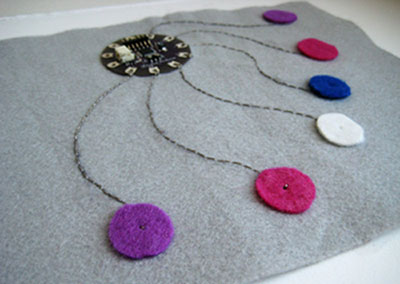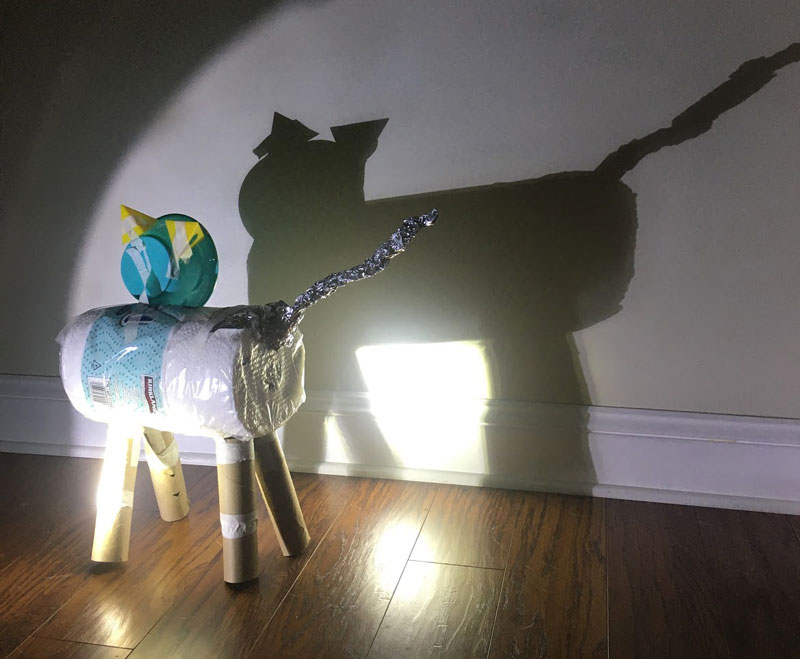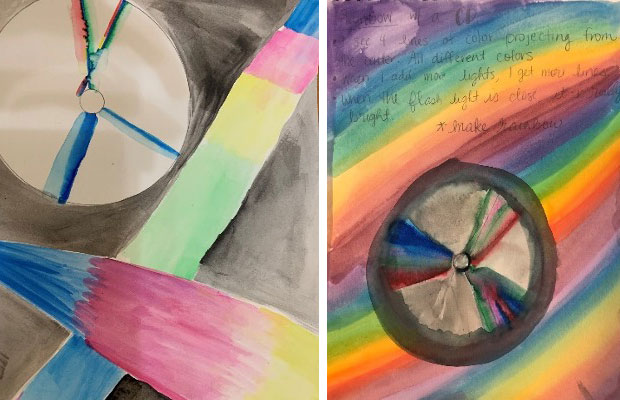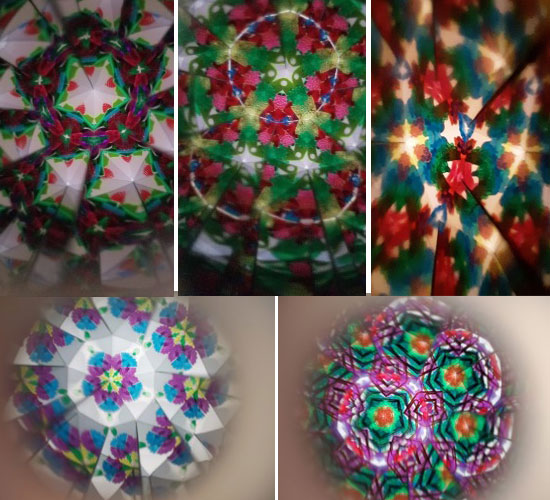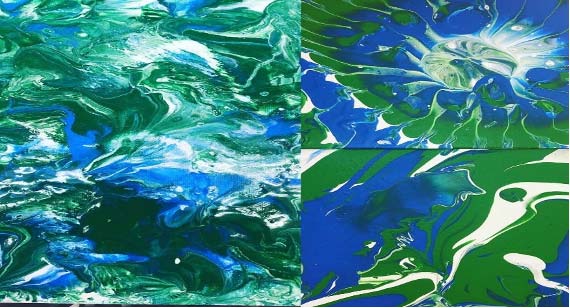UNDERSTANDING INFORMATIONAL TEXT THROUGH LANDSCAPE ART 6-8
UNDERSTANDING INFORMATIONAL TEXTTHROUGH LANDSCAPE ART
Learning Description
In this lesson, students will demonstrate their understanding of informational texts by using text evidence to create a landscape artwork.
Learning Targets
GRADE BAND: 6-8
CONTENT FOCUS: VISUAL ARTS, ELA, SOCIAL STUDIES
LESSON DOWNLOADS:
"I Can" Statements
“I Can…”
- I can visualize supporting details in an informational text to create a landscape artwork.
- I can annotate an informational text to identify the most important details.
- I can synthesize the information presented in two different texts.
Essential Questions
- How can I visualize supporting details in an informational text to create a landscape artwork?
- How can I identify the most important details using annotation?
- How can I synthesize the information presented in two different texts?
Georgia Standards
Curriculum Standards
Grade 6
ELA
ELAGSE6RI1 Cite textual evidence to support analysis of what the text says explicitly as well as inferences drawn from the text.
ELAGSE6RI2 Determine a central idea of a text and how it is conveyed through particular details; provide a summary of the text distinct from personal opinions or judgments.
SOCIAL STUDIES
SS6G1 Locate selected features of Latin America.
SS6G4 Locate selected features of Canada.
SS6G7 Locate selected features of Europe.
SS6G11 Locate selected features of Australia.
Grade 7
ELA
ELAGSE7RI1 Cite several pieces of textual evidence to support analysis of what the text says explicitly as well as inferences drawn from the text.
ELAGSE7W8 Gather relevant information from multiple print and digital sources, using search terms effectively; assess the credibility and accuracy of each source; and quote or paraphrase the data and conclusions of others while avoiding plagiarism and following a standard format for citation.
SOCIAL STUDIES
SS7G1 Locate selected features of Africa.
SS7G5 Locate selected features in Southwest Asia (Middle East).
SS7G9 Locate selected features in Southern and Eastern Asia.
Grade 8
ELAGSE8RI1 Cite the textual evidence that most strongly supports an analysis of what the text says explicitly as well as inferences drawn from the text.
ELAGSE8RI2 Determine a central idea of a text and analyze its development over the course of the text, including its relationship to supporting ideas; provide an objective summary of the text.
SOCIAL STUDIES
SS8G1 Describe Georgia’s geography and climate.
Arts Standards
Grade 6
VA6.CR.1 Visualize and generate ideas for creating works of art.
VA6.CR.2 Choose from a range of materials and/or methods of traditional and contemporary artistic practices to plan and create works of art.
VA6.CR.3 Engage in an array of processes, media, techniques, and/or technology through experimentation, practice, and persistence.
Grade 7
VA7.CR.1 Visualize and generate ideas for creating works of art.
VA7.CR.2 Choose from a range of materials and/or methods of traditional and contemporary artistic practices to plan and create works of art.
VA7.CR.3 Engage in an array of processes, media, techniques, and/or technology through experimentation, practice, and persistence.
Grade 8
VA8.CR.1 Visualize and generate ideas for creating works of art.
VA8.CR.2 Choose from a range of materials and/or methods of traditional and contemporary artistic practices to plan and create works of art.
VA8.CR.3 Engage in an array of processes, media, techniques, and/or technology through experimentation, practice, and persistence.
South Carolina Standards
Curriculum Standards
Grade 6
ELA
Reading - Informational Text (RI) - Meaning and Context
Standard 6: Summarize key details and ideas to support analysis of central ideas.
6.1 Provide an objective summary of a text with two or more central ideas; cite key supporting details.
Grade 7
ELA
Reading - Informational Text (RI) - Meaning and Context
Standard 6: Summarize key details and ideas to support analysis of central ideas.
6.1 Provide an objective summary of a text with two or more central ideas; cite key supporting details to analyze their development.
SOCIAL STUDIES
7.1.1.PR Identify select African physical systems and human characteristics of places.
7.2.1.PR Identify select Asian physical systems and human characteristics of places.
7.3.1.PR Identify select Australia, Oceania, and Antarctica physical systems and human characteristics of places.
7.4.1.PR Identify select European physical systems and human characteristics of places.
7.5.1.PR Identify select North American physical systems and human characteristics of places.
7.6.1.PR Identify select South American physical systems (e.g., landforms and bodies of water), and human characteristics of places (e.g., countries and cities).
Grade 8
ELA
Reading - Informational Text (RI) - Meaning and Context
Standard 6: Summarize key details and ideas to support analysis of central ideas.
6.1 Provide an objective summary of a text with two or more central ideas; cite key supporting details to analyze their development.
Arts Standards
Anchor Standard 1: I can use the elements and principles of art to create artwork.
Anchor Standard 2: I can use different materials, techniques, and processes to make art.
Anchor Standard 5: I can interpret (read) and evaluate the meaning of an artwork.
Anchor Standard 7: I can relate visual arts ideas to other arts disciplines, content areas, and careers.
Key Vocabulary
Content Vocabulary
- Informational text - Nonfiction writing that has the purpose of informing the reader
- Synthesize - To combine two or more sources of information into one coherent source of information
- Annotate - To take notes on a text
- Physical feature - A landform such as a mountain, river, desert, etc.
- Text evidence - Information that comes directly from the text that supports the main idea of the text
Arts Vocabulary
- Space - One of the seven Elements of Art; techniques artists use to create the illusion of depth on a 2D surface
- Landscape - A type of art that shows a wide expanse of land–usually a countryside–and shows depth through a background, middle ground, and foreground
- Foreground - The part of a landscape that is closest to the viewer
- Background - The part of a landscape that is farthest from the viewer
- Middle ground - The part of a landscape that is in between the background and the foreground
- Texture - One of the seven elements of art; how something feels or looks like it feels
- Printmaking - Printmaking is a process by which the artist creates an image that has texture and transfers that image repeatedly onto another surface like paper.
- Collagraph printmaking - A form of printmaking in which texture is built up on a surface by layering materials. The artist then transfers the image through a process like a rubbing onto another surface like paper.
Materials
- Computer paper
- Cardstock
- Cardboard or additional cardstock for background
- Scissors
- Glue sticks
- Pencils
- Crayons or oil pastels (teacher tip: soak oil pastels or crayons in warm soapy water overnight; paper labels will easily come off the next day)
- Informational text that describes a geographic location students are studying in Social Studies such as the Sahara Desert (7th grade SS, GA)
- Optional - colored pencils
Instructional Design
Opening/Activating Strategy
- Project a landscape painting such as Landscape from Saint Remy by Vincent Van Gogh.
- First, students will identify what they see in the image. Emphasize that they should make objective observations about the painting (i.e. physical features, colors, textures, etc.).
- Next, ask students to identify what they think about the image. Emphasize that students should be creating inferences using visual evidence from the painting.
- Finally, ask students what they wonder about the image.
- Ask students to work collaboratively to engage in the See, Think, Wonder protocol (Harvard University Project Zero - Artful Thinking Strategies).
- Facilitate a class-wide discussion around students’ observations, inferences, and questions.
Work Session
- Explain that the artwork students are looking at is an example of a landscape painting. Landscape paintings show a wide expanse of land–usually a countryside–and show depth through a background, middle ground, and foreground.
- Show students the diagram of a landscape. Explain that the background is what is farthest away from the viewer, the foreground is directly in front of the viewer, and the middle ground everything in the middle.
- Ask students to try to identify the background, middle ground, and foreground in Landscape from Saint Remy by Vincent Van Gogh.
- Explain to students that texture in art is how something feels or looks like it feels. Ask students to identify textures in the landscape painting.
- Tell students that they will be creating their own landscape artwork based off of an informational text. Provide each student with a copy of the informational text that connects to a region students are studying in Social Studies (if applicable).
- With partners, have students annotate the text as they read, looking for details that describe how the region looks such as landforms, colors, etc.
- Facilitate a discussion with students around what details they might include in the background, what details they might include in the middle ground, and what details they might include in the foreground.
- Instruct students to locate and research an additional informational text on the same region.
- Students should use their knowledge of research practices to identify a reliable source. Students should annotate the text as they did previously.
- Students will synthesize the details that they found in the two sources to create their landscape artwork.
- Introduce students to the term Collagraph Printmaking.
- Printmaking is a process by which the artist creates an image that has texture and transfers that image repeatedly onto another surface like paper.
- Tell students that the printing press is an early example of printmaking.
- Explain the process of creating their artwork.
- Students will draw a rough draft of their landscape on blank paper using evidence from both texts. Students’ rough drafts should have a background, middle ground, and foreground.
- Out of cardstock, students will cut out landforms like mountains and physical features like forests that they included in their rough draft.
- Students should glue the landforms down to a piece of cardstock or cardboard starting with the background and moving to the foreground.
- Students should use overlapping as they glue each layer down.
- Once they have created their landscapes, students will create a rubbing by placing a piece of computer paper over their landscape. Using a crayon or oil pastel, they will rub across the surface to pick up the texture of the landscape.
- Students can then add in details and additional texture using colored pencil, crayon, or oil pastel.
Closing Reflection
- Students will write a one paragraph artist statement about their work. They should include a relevant title for their landscape and what they showed in their artwork citing text evidence from both sources.
- Allow students to conduct a gallery walk within small groups to compare and contrast how they and their classmates visualized the text. Emphasize that students should look for similarities and differences in artwork and how that reflects the sources that students used.
Assessments
Formative
Teachers will assess learning by determining whether students are able to identify the background, middle ground, and foreground in the example landscape and whether students can identify all the important supporting details from both texts that describe how the region looks.
Summative
CHECKLIST
- Students’ landscapes included a background, middle ground, and foreground.
- Students’ landscapes visualize the details from both texts that describe how the location looks.
- Students’ artist statements include a relevant title for their landscapes and what they showed in their artwork citing text evidence from both sources.
Differentiation
|
Acceleration:
Remediation:
|
ADDITIONAL RESOURCES
|
*This integrated lesson provides differentiated ideas and activities for educators that are aligned to a sampling of standards. Standards referenced at the time of publishing may differ based on each state’s adoption of new standards.
Ideas contributed by: Katy Betts
Revised and copyright: 2023 @ ArtsNOW

